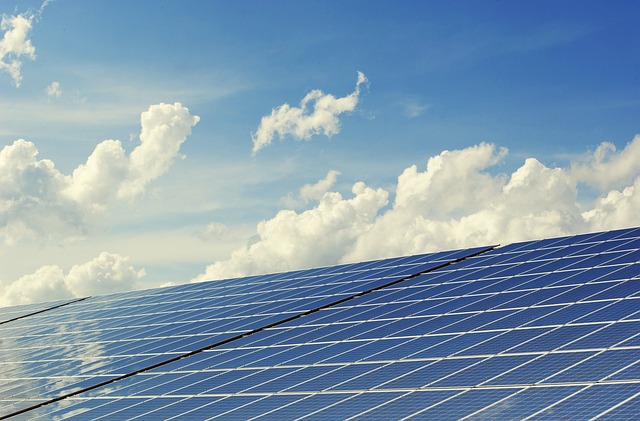“Power Your Future: Achieve Seamless Integration of Solar Panels and Inverters for Maximum Efficiency.”
Achieving seamless integration between solar panels and inverters is crucial for optimizing the performance and efficiency of solar energy systems. This process involves ensuring that the components work harmoniously to convert sunlight into usable electricity while maximizing energy output and minimizing losses. Key factors include selecting compatible equipment, understanding electrical specifications, implementing proper installation techniques, and utilizing advanced technologies such as smart inverters and monitoring systems. By focusing on these elements, users can enhance the reliability and effectiveness of their solar energy systems, ultimately leading to greater energy independence and sustainability.
Choosing the Right Inverter for Your Solar Panels
Choosing the right inverter for your solar panels is a critical step in ensuring the efficiency and effectiveness of your solar energy system. The inverter serves as the heart of the solar setup, converting the direct current (DC) generated by the solar panels into alternating current (AC), which is the form of electricity used in homes and businesses. Therefore, understanding the different types of inverters available and their compatibility with your solar panels is essential for achieving seamless integration.
First and foremost, it is important to consider the type of inverter that best suits your solar panel system. There are three primary types of inverters: string inverters, microinverters, and power optimizers. String inverters are the most common choice for residential solar systems. They connect multiple solar panels in a series, allowing for a simplified installation and cost-effective solution. However, one drawback is that if one panel underperforms due to shading or dirt, the entire string’s output can be affected. This is where microinverters come into play. Microinverters are installed on each individual panel, allowing for maximum energy production from each unit. This can be particularly beneficial in installations where shading is a concern or where panels are oriented in different directions. Power optimizers, on the other hand, combine features of both string inverters and microinverters. They are installed on each panel but still connect to a central string inverter, providing some of the benefits of individual panel optimization while maintaining a simpler installation process.
Once you have determined the type of inverter that aligns with your solar panel setup, the next step is to ensure that the inverter’s specifications match the output of your solar panels. This involves looking at the inverter’s power rating, which should be compatible with the total wattage of your solar array. It is generally recommended to choose an inverter with a power rating that is slightly higher than the total output of your solar panels to accommodate for peak production times and to ensure optimal performance. Additionally, pay attention to the inverter’s efficiency rating, as this will directly impact the amount of energy converted and utilized. A higher efficiency rating means less energy loss during the conversion process, which translates to more usable power for your home.
Moreover, it is crucial to consider the inverter’s warranty and lifespan. Most inverters come with warranties ranging from five to twenty years, and investing in a reliable inverter with a longer warranty can provide peace of mind and protect your investment. Furthermore, the lifespan of an inverter typically ranges from five to fifteen years, so selecting a high-quality product can minimize the need for replacements and maintenance over time.
In addition to these technical specifications, it is also wise to consider the inverter’s features, such as monitoring capabilities and grid compatibility. Many modern inverters come equipped with monitoring systems that allow homeowners to track their energy production and consumption in real-time. This can be invaluable for optimizing energy use and identifying any potential issues early on. Furthermore, ensuring that the inverter is compatible with local grid requirements is essential for a smooth connection and compliance with regulations.
In conclusion, choosing the right inverter for your solar panels involves a careful evaluation of the inverter type, specifications, warranty, and additional features. By taking the time to select an appropriate inverter, you can ensure a seamless integration with your solar panel system, maximizing energy production and enhancing the overall efficiency of your renewable energy setup.
Best Practices for Wiring Solar Panels and Inverters

Achieving seamless integration between solar panels and inverters is crucial for optimizing the performance of a solar energy system. One of the most significant aspects of this integration lies in the wiring process, which requires careful planning and execution to ensure efficiency and safety. To begin with, it is essential to select the appropriate wire gauge for the specific application. The wire gauge must be capable of handling the maximum current produced by the solar panels while minimizing voltage drop. A common practice is to refer to the National Electrical Code (NEC) guidelines, which provide recommendations on wire sizes based on the current and distance between the solar panels and the inverter.
In addition to selecting the right wire gauge, it is vital to use high-quality, UV-resistant cables designed for outdoor use. These cables should be rated for the voltage and temperature conditions expected in the installation environment. Using subpar materials can lead to premature degradation, which not only affects performance but can also pose safety risks. Furthermore, employing connectors that are compatible with both the solar panels and the inverter is essential. This compatibility ensures a secure and reliable connection, reducing the likelihood of energy loss due to poor contact.
When it comes to the actual wiring process, maintaining a clean and organized layout is paramount. This organization not only facilitates easier troubleshooting in the future but also enhances the overall aesthetic of the installation. It is advisable to use cable management systems, such as conduits or cable ties, to keep wires neatly arranged and protected from environmental factors. Additionally, ensuring that wires are not exposed to sharp edges or potential pinch points can prevent damage over time.
Moreover, proper grounding is a critical component of wiring solar panels and inverters. Grounding helps protect the system from electrical surges and lightning strikes, which can cause significant damage. It is essential to follow local codes and regulations regarding grounding practices, which typically involve connecting the inverter and solar panel frames to a grounding rod. This connection should be made using appropriately sized grounding wire to ensure effective dissipation of electrical surges.
As the installation progresses, it is also important to consider the layout of the solar panels themselves. The orientation and tilt of the panels can affect the overall efficiency of the system, and this should be taken into account when planning the wiring. Ensuring that the panels are wired in a manner that optimizes their exposure to sunlight will enhance energy production. Additionally, using a string inverter or microinverters can influence how the panels are wired together, with each option presenting its own set of advantages and challenges.
Finally, once the wiring is complete, conducting thorough testing is essential to verify that the system operates as intended. This testing should include checking for continuity, ensuring that there are no short circuits, and confirming that the voltage levels are within acceptable ranges. By following these best practices for wiring solar panels and inverters, installers can achieve a seamless integration that maximizes energy production while ensuring safety and reliability. Ultimately, a well-executed wiring process lays the foundation for a successful solar energy system, enabling homeowners and businesses to harness the power of the sun effectively.
Understanding Solar Panel and Inverter Compatibility
Achieving seamless integration between solar panels and inverters is crucial for maximizing the efficiency and performance of a solar energy system. To begin with, understanding the compatibility between these two components is essential. Solar panels convert sunlight into direct current (DC) electricity, while inverters transform this DC electricity into alternating current (AC), which is the form of electricity used in most homes and businesses. Therefore, the compatibility between solar panels and inverters directly impacts the overall effectiveness of the solar energy system.
One of the primary factors to consider when assessing compatibility is the electrical specifications of both components. Solar panels are rated based on their voltage and current output, which can vary significantly depending on the type and model. Inverters, on the other hand, have specific input voltage and current ranges they can handle. It is vital to ensure that the output of the solar panels falls within the acceptable input range of the inverter. If the voltage or current exceeds the inverter’s specifications, it can lead to inefficiencies or even damage the inverter, resulting in costly repairs or replacements.
Moreover, the type of inverter plays a significant role in compatibility. There are several types of inverters available, including string inverters, microinverters, and power optimizers. String inverters are commonly used in residential systems, where multiple solar panels are connected in series. In contrast, microinverters are installed on each individual panel, allowing for greater flexibility and efficiency, especially in shaded conditions. Power optimizers, while not inverters themselves, work in conjunction with string inverters to enhance performance by optimizing the output of each panel. Understanding the specific requirements and advantages of each inverter type can help in selecting the most suitable option for a given solar panel system.
In addition to electrical specifications and inverter types, the physical compatibility of solar panels and inverters should not be overlooked. This includes considerations such as mounting options, wiring configurations, and installation space. For instance, some inverters may require specific mounting hardware or configurations that may not align with certain solar panel designs. Therefore, it is essential to consult the manufacturer’s guidelines and installation manuals to ensure that both components can be integrated without any issues.
Furthermore, it is important to consider the overall system design and layout. The arrangement of solar panels and the inverter’s location can significantly affect performance. For example, if the inverter is placed too far from the solar panels, voltage drop can occur, leading to reduced efficiency. Therefore, careful planning of the system layout is necessary to minimize losses and ensure optimal performance.
Lastly, it is advisable to work with experienced professionals when designing and installing a solar energy system. They can provide valuable insights into the latest technologies and compatibility considerations, ensuring that the selected solar panels and inverters work harmoniously together. By prioritizing compatibility and understanding the nuances of both components, homeowners and businesses can achieve a seamless integration that maximizes energy production and enhances the overall effectiveness of their solar energy systems. In conclusion, a thorough understanding of solar panel and inverter compatibility is fundamental to harnessing the full potential of solar energy, paving the way for a sustainable and efficient energy future.
Troubleshooting Common Integration Issues Between Solar Panels and Inverters
Achieving seamless integration between solar panels and inverters is crucial for maximizing the efficiency and performance of a solar energy system. However, various integration issues can arise, leading to suboptimal energy production and potential system failures. Understanding these common problems and their solutions is essential for both installers and homeowners looking to optimize their solar setups.
One of the most frequent issues encountered during integration is mismatched specifications between solar panels and inverters. This mismatch can occur when the voltage and current ratings of the solar panels do not align with the inverter’s input requirements. For instance, if the solar panels produce a higher voltage than the inverter can handle, it may lead to overvoltage conditions, causing the inverter to shut down or even sustain damage. To prevent this, it is vital to carefully review the specifications of both components before installation. Ensuring that the inverter is compatible with the solar panel’s output characteristics will help avoid these complications.
Another common issue is the improper configuration of the inverter settings. Inverters often come with various settings that need to be adjusted based on the specific characteristics of the solar panels and the overall system design. For example, if the inverter is set to operate at a different frequency than what the solar panels are producing, it can lead to inefficiencies or even system failure. Therefore, it is essential to consult the manufacturer’s guidelines and, if necessary, seek professional assistance to ensure that the inverter settings are correctly configured for optimal performance.
Additionally, wiring problems can significantly impact the integration of solar panels and inverters. Poor connections, inadequate wire gauge, or damaged cables can lead to energy losses and reduced system efficiency. For instance, using wires that are too thin can result in voltage drops, which may prevent the inverter from receiving the necessary power from the solar panels. To mitigate these issues, it is crucial to use high-quality wiring and ensure that all connections are secure and properly insulated. Regular inspections of the wiring can also help identify any potential problems before they escalate.
Moreover, shading can pose a significant challenge to the seamless integration of solar panels and inverters. When solar panels are partially shaded, their output can be drastically reduced, leading to inefficiencies in the entire system. In such cases, the inverter may struggle to optimize the energy harvested from the panels. To address this issue, it is advisable to conduct a thorough site assessment before installation to identify potential shading sources, such as trees or nearby buildings. Implementing strategies like optimizing panel placement or using microinverters can help mitigate the effects of shading and enhance overall system performance.
Lastly, monitoring and maintenance play a critical role in ensuring the long-term success of solar panel and inverter integration. Regularly checking the system’s performance through monitoring tools can help identify any discrepancies or issues that may arise over time. By staying proactive and addressing problems promptly, homeowners can ensure that their solar energy systems operate at peak efficiency.
In conclusion, troubleshooting common integration issues between solar panels and inverters requires a comprehensive understanding of the components involved and their interactions. By paying attention to specifications, configurations, wiring, shading, and ongoing maintenance, users can achieve a seamless integration that maximizes energy production and enhances the overall performance of their solar energy systems.
Q&A
1. **Question:** What is the first step to achieve seamless integration between solar panels and inverters?
**Answer:** The first step is to ensure compatibility between the solar panels and the inverter by checking their specifications, such as voltage and current ratings.
2. **Question:** How can proper wiring contribute to seamless integration?
**Answer:** Proper wiring ensures that the electrical connections between the solar panels and the inverter are secure and efficient, minimizing energy loss and preventing potential damage.
3. **Question:** What role does monitoring play in integration?
**Answer:** Monitoring systems help track the performance of both solar panels and inverters, allowing for real-time adjustments and maintenance to ensure optimal operation.
4. **Question:** Why is it important to follow installation guidelines?
**Answer:** Following installation guidelines ensures that the system is set up correctly, reducing the risk of malfunctions and enhancing the overall efficiency of the solar energy system.
Conclusion
To achieve seamless integration between solar panels and inverters, it is essential to ensure compatibility between the components, utilize high-quality equipment, and follow best practices in installation. Proper system design, including the correct sizing of inverters to match the solar array output, is crucial. Implementing advanced monitoring systems can enhance performance and facilitate troubleshooting. Regular maintenance and updates to software and firmware will also contribute to optimal operation. By focusing on these aspects, a reliable and efficient solar energy system can be established, maximizing energy production and system longevity.




